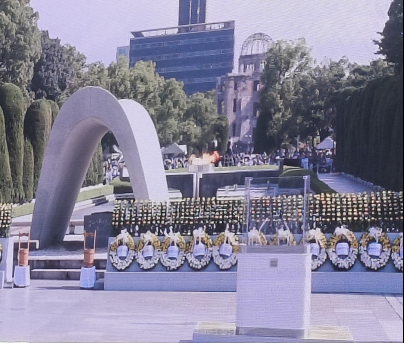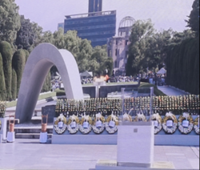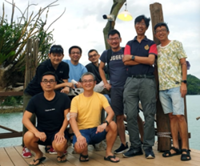(From left) The writer, Inosuke and the writer's wife in February 2020. — Photos: DR LEE CHENG HOCK
I visited Hiroshima in 2019 and Nagasaki in 2020 just before the Covid-19 lock down happened.
While at the Nagasaki Peace Park, I met an atomic bomb survivor (hibakusha), Inosuke Hayasaki. As a member of the Nagasaki Foundation for the Promotion of Peace, he is in the park almost daily, encouraging visitors to ring the peace bell in the park at 11.02am everyday.
As 2025 marks the 80th anniversary of the atomic bombing of Hiroshima and Nagasaki, I decided to visit these cities in the hope of meeting up with Inosuke. Unfortunately, he had passed away in April 2023 at a ripe age of 92.
Arriving in Hiroshima, I noticed that there is a new elevated tram station in the main transportation hub. New trams were introduced while some lines retain the old vintage streetcars.
A day pass entitles one to an unlimited travel on the trams as well as a free ferry ride to the nearby Miyajima island.
There are multiple walking trails in Miyajima and if one is short of time, one can take the Miyajima Ropeway (cable car) to Mt Misen.
Along the way one can enjoy the spectacular views of Miyajima and Seto inland sea.
Hiroshima is connected to Nagasaki by road and rail. I took a one-hour Shinkansen from Hiroshima station to Hakata station in Fukuoka. From Hakata station, a limited express train connects to Takeo Onsen station.
From Takeo Onsen station, it is a 30 minute Shinkansen to Nagasaki station.
Nagasaki has not significantly changed since my last visit. The same tram service and a little Chinatown still charms visitors.
The 80th anniversary of the atomic bombing of Hiroshima and Nagasaki was celebrated on a grand scale.
During the ceremony in Hiroshima, I met a fellow veteran, Lt Col Thomas from Germany. There were group prayers and choir singing as well as protests from fringe groups in Hiroshima on Aug 5 and 6, 2025 in the grounds adjacent to the atomic bomb dome and the riverside.
Visitors were encouraged to purchase and fold lanterns to be released into the river on the evening of Aug 6, 2025.
In Nagasaki, those without passes were ushered into the hall in the atomic museum. We were entertained to a musical by students using bells of different sizes and an eulogy by a hibakusha. The weather in Nagasaki spectacularly improved after a chorus by a group of hibakusha.
During both ceremonies, there were traditional speeches by VIPs, laying to rest the list of victims who died during the previous year, offering of water from the nearby rivers and flowers, chorus by school children followed by silent prayers and ringing of the bells at 8.15am in Hiroshima and 11.02am in Nagasaki.
The ceremonies ended with the declaration for peace and the hope that atomic bombs will never be used again.







